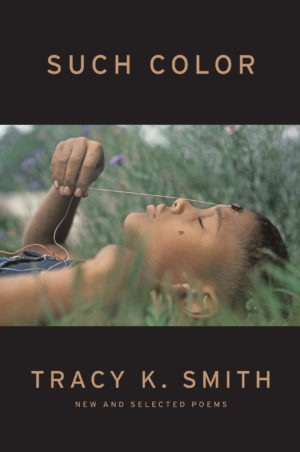Such Color
by Tracy K. Smith
reviewed by Sylee Gore
Such Color combines eighteen new poems with selections from Tracy K. Smith’s previous four prize-winning books. If the collection had a preface, it might gloss the writer’s journey from a childhood as the youngest of five in Massachusetts and northern California to her studies at Harvard and Columbia, her Pulitzer Prize, her tenure as US Poet Laureate, and her faculty roles (as of 2021, at Harvard). Across two hundred pages, this volume, published as Smith turns fifty, gives an overview of her remarkable oeuvre. It opens with a speaker “looking for myself” in “pale blank faces” and ends with “Riot,” in which a collective voice declares:
We live—
gold hot bright
the line of us
never tiring
We live—
We live—
The elements of Such Color are heat, wonder, and a clear-eyed appraisal of the suffering wrought by enslavement, individual violence, systemic racism, and civil conflict. Even in first-person lyric poems, Smith remains attuned to how individual lives are embedded in wider society. Her debut, The Body’s Question (2003), features a sequence of “gospels” from Manuel, Miguel, Luis, Juan, Alejandro, and Jesús, who move from “mountains built of fog” to “a wide, black, furious serpent” of a river to reach a border “crossed / On our bellies” before entering a new country, one which “Never stopped being our country.” Though Smith shows her awe of the world, she does not retreat from its injustices.
The angle of attention remains broad in the poet’s second book, Duende (2007), which starts with “History”:
This is a poem about the itch
That stirs a nation at night.This is a poem about all we’ll do
Not to scratch—
Duende closes by contemplating “The Nobodies” who “rise from the dawn and dress,” then “raise the bundles to their heads” to take up menial labor, and “swallow / What they are given.” The poet describes the Nobodies speaking a “language of kicked stones”; other poems contain a “language of vowels,” one “like globes of air”; a “language of pigment” and “a language built from brick and bone.” Smith’s genius lies in transmuting these unwritten languages of ether and earth onto the page.
The sequence “In Which the Dead Send Postcards to Their Assailants from America’s Most Celebrated Landmarks” gives voice to murder victims in chilling epistolary poems. “Dear Shawna, How are you?” writes the nine-year-old Brisenia Flores to the woman who ordered her death, before continuing, “Today we took a boat out to an island. It was cold even though the sun was hot on my skin.” In “I Will Tell you the Truth about This, I Will Tell You All about It” from Wade in the Water (2018), collaged epistolary poems capture the dignity of Black Americans during the Civil War, excerpting their statements with forensic precision to depict their pleas for even the most basic knowledge of their legal status:
Mr president It is my Desire to be free to go to see my people
on the eastern shore my mistress wont let me you will please
let me know if we are free and what i can do
Even in the face of the world’s inhumanities, the poet’s voice never numbs. She catches the reader’s breath with her imagery, which describes “static like gristly meat,” voices “like metal shavings / In molasses,” boats “Buzzing like mosquitos,” and “the Black in my heart / like a map // made of tar.”
The poem “An Old Story” appears on the back cover in place of the usual laudatory endorsements. It ends:
Then animals long believed gone crept down
From trees. We took new stock of one another.
We wept to be reminded of such color.
The color is ourselves. Such Color is our color. What we share may yet be more than what we have destroyed or been robbed of.
In the chapbook-sized Riot (2021), which concludes Such Color, Smith’s poems taper into sonically explosive short lines:
This is not the riot.
This is reality. It rolls,roils, briefly recoils.
It hammers down. We fall,rebound. You chase,
we race. You hate,we wait.
The staccato subtlety of these incendiary final poems is the dedicated reader’s reward. In Such Color, Smith has forged a remarkably cohesive collection by joining the accumulated force of her first four books with the momentum of her newest work. These poems confidently range across time, space, and national boundaries and speak to the current moment with a needed charge.
Published on April 1, 2022

